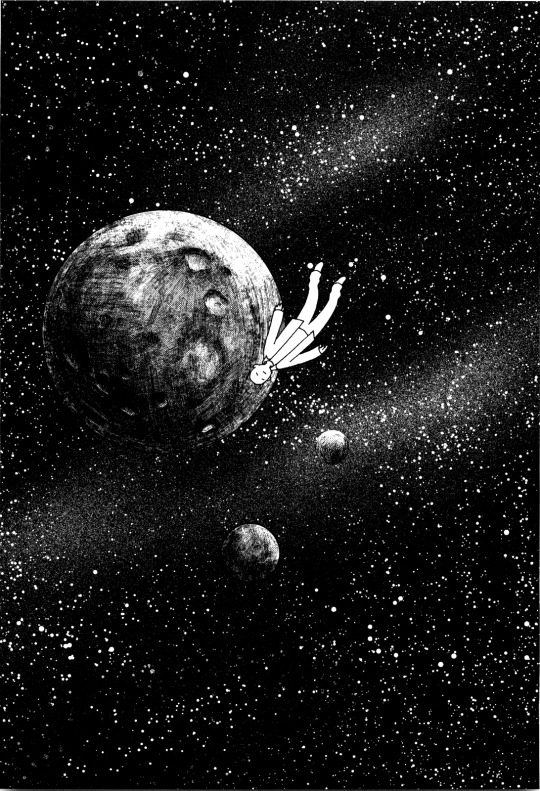#Hikidashi ni Terrarium
Explore tagged Tumblr posts
Text
if you need more ryoko kui fantasy I highly recommend her one shot collections!!! In order: Terrarium in Drawer, The Dragon's School is on Top of the Mountain, Seven Little Sons of the Dragon
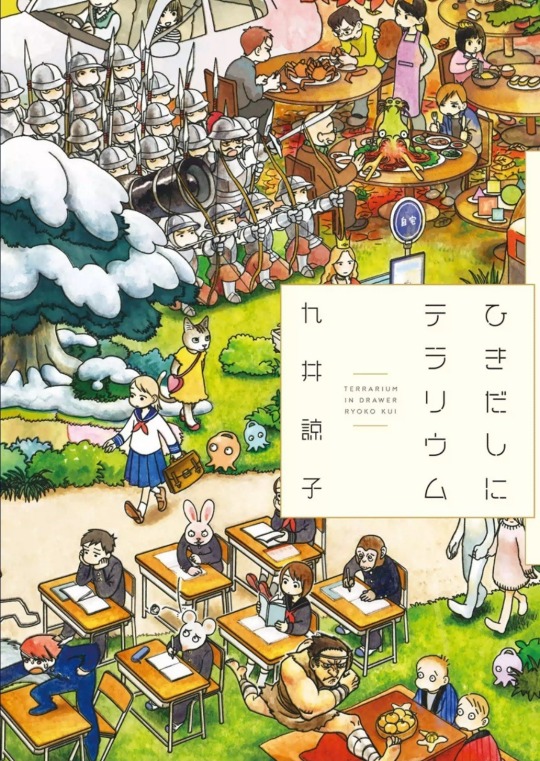
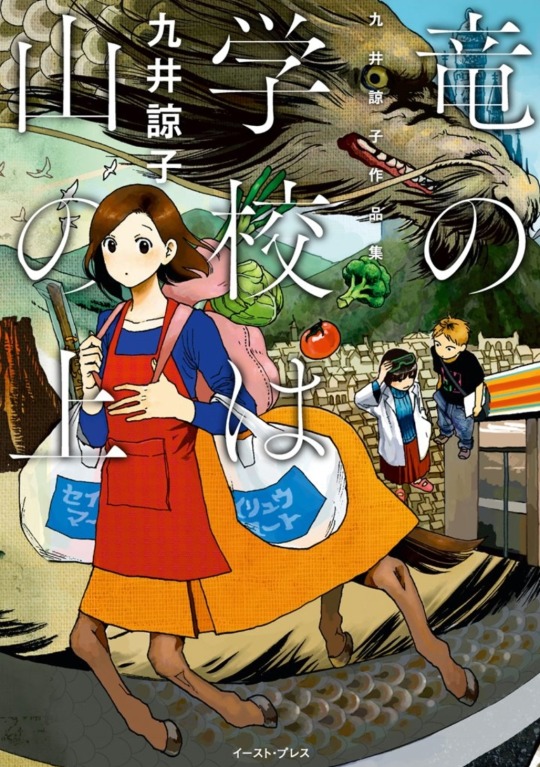
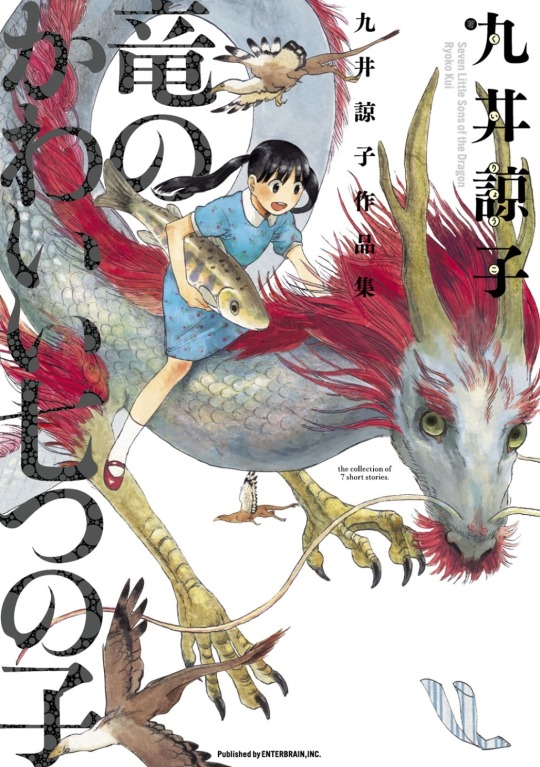
#i am once again promoting these jgdfhjkl#ryoko kui#the dragons school is on top of the mountain#the works of ryoko kui seven little sons of the dragon#dungeon meshi#terrarium in a drawer#ryuu no gakkou wa yama no ue#hikidashi ni terrarium#kui ryouko sakuhinshuu#ryuu no kawaii nanatsu no ko
374 notes
·
View notes
Text
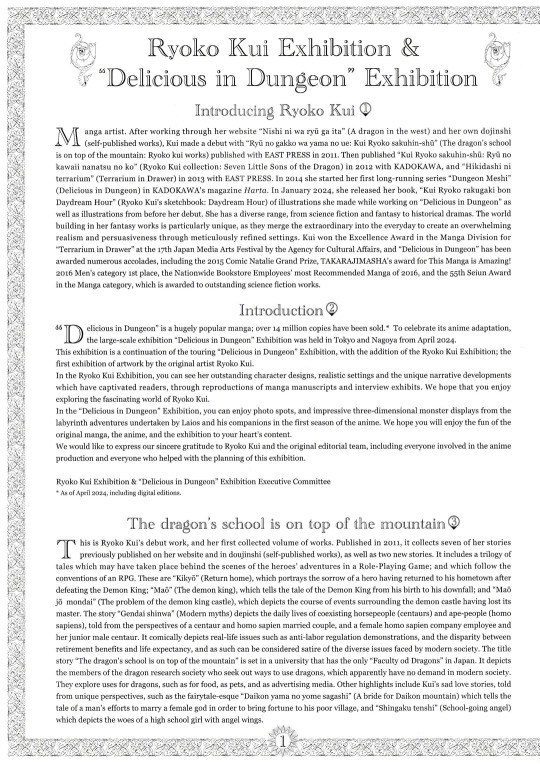
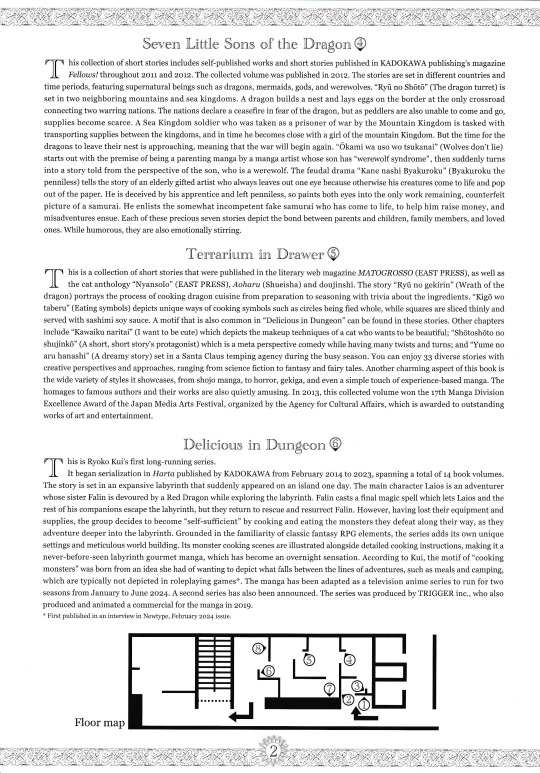




Ryoko Kui Exhibition & ''Delicious in Dungeon'' Exhibition pamphlet
Transcript under the cut
Disclaimer is that I used an image to text website and then proof-read it myself and made corrections where it got the text wrong. There was a few typos in the original text (like writing fied instead of fried) but I kept those in just in case I interpreted something as a typo but it wasn't.
[page 1]
Ryoko Kui Exhibition & "Delicious in Dungeon" Exhibition Introducing Ryoko Kui (1) Manga artist. After working through her website "Nishi ni wa ryū ga ita" (A dragon in the west) and her own dojinshi (self-published works), Kui made a debut with "Ryu no gakko wa yama no ue: Kui Ryoko sakuhin-shu" (The dragon's school is on top of the mountain: Ryoko kui works) published with EAST PRESS in 2011. Then published "Kui Ryoko sakuhin-shu: Ryū no kawaii nanatsu no ko" (Ryoko Kui collection: Seven Little Sons of the Dragon) in 2012 with KADOKAWA, and "Hikidashi ni terrarium" (Terrarium in Drawer) in 2013 with EAST PRESS. In 2014 she started her first long-running series "Dungeon Meshi" (Delicious in Dungeon) in KADOKAWA's magazine Harta. In January 2024, she released her book, "Kui Ryoko rakugaki bon Daydream Hour" (Ryoko Kui's sketchbook: Daydream Hour) of illustrations she made while working on "Delicious in Dungeon" as well as illustrations from before her debut. She has a diverse range, from science fiction and fantasy to historical dramas. The world building in her fantasy works is particularly unique, as they merge the extraordinary into the everyday to create an overwhelming realism and persuasiveness through meticulously refined settings. Kui won the Excellence Award in the Manga Division for "Terrarium in Drawer" at the 17th Japan Media Arts Festival by the Agency for Cultural Affairs, and "Delicious in Dungeon" has been awarded numerous accolades, including the 2015 Comic Natalie Grand Prize, TAKARAJIMASHA's award for This Manga is Amazing! 2016 Men's category 1st place, the Nationwide Bookstore Employees' most Recommended Manga of 2016, and the 55th Seiun Award in the Manga category, which is awarded to outstanding science fiction works. Introduction (2) Delicious in Dungeon" is a hugely popular manga; over 14 million copies have been sold.* To celebrate its anime adaptation, the large-scale exhibition "Delicious in Dungeon" Exhibition was held in Tokyo and Nagoya from April 2024. This exhibition is a continuation of the touring "Delicious in Dungeon" Exhibition, with the addition of the Ryoko Kui Exhibition; the first exhibition of artwork by the original artist Ryoko Kui. In the Ryoko Kui Exhibition, you can see her outstanding character designs, realistic settings and the unique narrative developments which have captivated readers, through reproductions of manga manuscripts and interview exhibits. We hope that you enjoy exploring the fascinating world of Ryoko Kui. In the "Delicious in Dungeon" Exhibition, you can enjoy photo spots, and impressive three-dimensional monster displays from the labyrinth adventures undertaken by Laios and his companions in the first season of the anime. We hope you will enjoy the fun of the original manga, the anime, and the exhibition to your heart's content. We would like to express our sincere gratitude to Ryoko Kui and the original editorial team, including everyone involved in the anime production and everyone who helped with the planning of this exhibition.
Ryoko Kui Exhibition & "Delicious in Dungeon" Exhibition Executive Committee
As of April 2024, including digital editions.
The dragon's school is on top of the mountain (3) This is Ryoko Kui's debut work, and her first collected volume of works. Published in 2011, it collects seven of her stories previously published on her website and in doujinshi (self-published works), as well as two new stories. It includes a trilogy of tales which may have taken place behind the scenes of the heroes' adventures in a Role-Playing Game; and which follow the conventions of an RPG. These are "Kikyō" (Return home), which portrays the sorrow of a hero having returned to his hometown after defeating the Demon King; "Mao" (The demon king), which tells the tale of the Demon King from his birth to his downfall; and "Maō jō mondai" (The problem of the demon king castle), which depicts the course of events surrounding the demon castle having lost its master. The story "Gendai shinwa" (Modern myths) depicts the daily lives of coexisting horsepeople (centaurs) and ape-people (homo sapiens), told from the perspectives of a centaur and homo sapien married couple, and a female homo sapien company employee and her junior male centaur. It comically depicts real-life issues such as anti-labor regulation demonstrations, and the disparity between retirement benefits and life expectancy, and as such can be considered satire of the diverse issues faced by modern society. The title story "The dragon's school is on top of the mountain" is set in a university that has the only "Faculty od Dragons" in Japan. It depicts the members of the dragon research society who seek out ways to use dragons, which apparently have no demand in modern society. They explore uses for dragons, such as for food, as pets, and as advertising media. Other highlights include Kui's sad love stories, told from unique perspectives, such as the fairytale-esque "Daikon yama no yome sagashi" (A bride for Daikon mountain) which tells the tale of a man's efforts to marry a female god in order to bring fortune to his poor village, and "Shingaku tenshi" (School-going angel) which depicts the woes of a high school girl with angel wings.
[page 2]
Seven Little Sons of the Dragon (4) This collection of short stories includes self-published works and short stories published in KADOKAWA publishing's magazine Fellows! throughout 2011 and 2012. The collected volume was published in 2012. The stories are set in different countries and time periods, featuring supernatural beings such as dragons, mermaids, gods, and werewolves. "Ryū no Shōtō” (The dragon turret) is set in two neighboring mountains and sea kingdoms. A dragon builds a nest and lays eggs on the border at the only crossroad connecting two warring nations. The nations declare a ceasefire in fear of the dragon, but as peddlers are also unable to come and go, supplies become scarce. A Sea Kingdom soldier who was taken as a prisoner of war by the Mountain Kingdom is tasked with transporting supplies between the kingdoms, and in time he becomes close with a girl of the mountain Kingdom. But the time for the dragons to leave their nest is approaching, meaning that the war will begin again. “Ōkami wa uso wo tsukanai" (Wolves don't lie) starts out with the premise of being a parenting manga by a manga artist whose son has "werewolf syndrome", then suddenly turns into a story told from the perspective of the son, who is a werewolf. The feudal drama "Kane nashi Byakuroku" (Byakuroku the penniless) tells the story of an elderly gifted artist who always leaves out one eye because otherwise his creatures come to life and pop out of the paper. He is deceived by his apprentice and left penniless, so paints both eyes into the only work remaining, counterfeit picture of a samurai. He enlists the somewhat incompetent fake samurai who has come to life, to help him raise money, and misadventures ensue. Each of these precious seven stories depict the bond between parents and children, family members, and loved ones. While humorous, they are also emotionally stirring.
Terrarium in Drawer (5) This is a collection of short stories that were published in the literary web magazine MATOGROSSO (EAST PRESS), as well as the cat anthology “Nyansolo” (EAST PRESS), Aoharu (Shueisha) and doujinshi. The story “Ryū no gekirin" (Wrath of the dragon) portrays the process of cooking dragon cuisine from preparation to seasoning with trivia about the ingredients. "Kigō wo taberu" (Eating symbols) depicts unique ways of cooking symbols such as circles being fied whole, while squares are sliced thinly and served with sashimi soy sauce. A motif that is also common in "Delicious in Dungeon" can be found in these stories. Other chapters include “Kawaiku naritai" (I want to be cute) which depicts the makeup techniques of a cat who wants to be beautiful; "Shōtoshōto no shujinkō" (A short, short story's protagonist) which is a meta perspective comedy while having many twists and turns; and "Yume no aru hanashi" (A dreamy story) set in a Santa Claus temping agency during the busy season. You can enjoy 33 diverse stories with creative perspectives and approaches, ranging from science fiction to fantasy and fairy tales. Another charming aspect of this book is the wide variety of styles it showcases, from shojo manga, to horror, gekiga, and even a simple touch of experience-based manga. The homages to famous authors and their works are also quietly amusing. In 2013, this collected volume won the 17th Manga Division Excellence Award of the Japan Media Arts Festival, organized by the Agency for Cultural Affairs, which is awarded to outstanding works of art and entertainment.
Delicious in Dungeon (6) This is Ryoko Kui's first long-running series. It began serialization in Harta published by KADOKAWA from February 2014 to 2023, spanning a total of 14 book volumes. The story is set in an expansive labyrinth that suddenly appeared on an island one day. The main character Laios is an adventurer whose sister Falin is devoured by a Red Dragon while exploring the labyrinth. Falin casts a final magic spell which lets Laios and the rest of his companions escape the labyrinth, but they return to rescue and resurrect Falin. However, having lost their equipment and supplies, the group decides to become "self-sufficient” by cooking and eating the monsters they defeat along their way, as they adventure deeper into the labyrinth. Grounded in the familiarity of classic fantasy RPG elements, the series adds its own unique settings and meticulous world building. Its monster cooking scenes are illustrated alongside detailed cooking instructions, making it a never-before-seen labyrinth gourmet manga, which has become an overnight sensation. According to Kui, the motif of "cooking monsters" was born from an idea she had of wanting to depict what falls between the lines of adventures, such as meals and camping, which are typically not depicted in roleplaying games*. The manga has been adapted as a television anime series to run for two seasons from January to June 2024. A second series has also been announced. The series was produced by TRIGGER inc., who also produced and animated a commercial for the manga in 2019.
First published in an interview in Newtype, February 2024 issue.
[Map showing the numbers from each ection from 1 to 8]
[page 3]
"Delicious in Dungeon" Artwork (separate post with pics) Cover illustration draft, vol. 1 Since this was the first volume, I tried out a few different drawings and had the editor and designer choose which ones they wanted, then made small adjustments. I personally liked the top-down draft, and the one of the cooking processes (back cover) the best. But looking back, I sincerely think it's good that we didn't go with those. (Kui)
Cover illustration draft, vol. 2 The format was decided for volume 1. So, volume 2 came together quickly. (Kui)
Cover illustration draft, vol. 3 I thought it might be cool to make the character Chilchuck darker in the foreground, and the background brighter! But it didn't quite work out the way I had imagined. I think it could have been a bit better. (Kui)
Cover illustration draft, vol. 4 I remember that the overall shape of volume 4 came together very quickly. The character Senshi's hands didn't fit nicely, so I moved them backwards and to the side. (Kui)
Cover illustration draft, vol. 5 I thought people might start to think "how many have I bought?" so I wanted to create a slightly different impression with this volume. I decided to put the character right in the center and try putting it together all in blue and green hues. (Kui)
Cover illustration draft, vol. 6 With the Red Dragon defeated, have we reached the halfway point in the story? With this in mind, I thought of how many volumes were left to go, and the number of characters, and decided to pair up the characters Namari and Shuroiro. In hindsight, it would have been fine to have them on one cover each. (Kui)
Cover illustration draft, vol. 7 The image is of focus lines converging on the character Izutsumi. This is the kind of cover, with upside down characters, which I've always wanted to try once(?) I submitted it as a trial, thinking that at this point the cover wouldn't dramatically influence sales. However, in the end, we decided it would be better not to have it upside down. (Kui)
Cover illustration draft, vol. 8 I tried blurring the mushrooms in the foreground, then I accidentally saved over it, and couldn't go back to the original. I remember apologizing that it was probably tacky, when I submitted it. (Kui)
Cover illustration draft, vol. 9 I don't think snake meat is marbled at all, but if it has an unfamiliar look, people might not recognize it as meat… so I made it look like beef to make it easier to understand. (Kui)
Cover illustration draft, vol. 10 I thought it might be interesting to have more than one of the main characters on the cover again, so I added the character Falin. I remember it wasn't badly received, but it still ended up just being Thistle on his own. (Kui)
Cover illustration draft, vol. 11 I wanted this cover to be covered in shiny gold. After I finished it, it didn't have enough color, so I painted the tablecloth green, and it ended up looking like Christmas colors. (Kui)
Cover illustration draft, vol. 12 Up to this point, the covers have featured one of the main characters holding cooking utensils in the foreground and a monster in the background, but I thought it might be interesting to reverse the format just before the final volume, so I drew this cover with that in mind. (Kui)
Cover illustration draft, vol. 13 volume 13 was meant to be the final one, but it was too thick to be published as a single volume, so we decided to split it into two. The question of “so, what should I draw next!?" may be at the forefront of volume 13. (Kui)
Cover illustration draft, vol. 14 I had decided that the final cover definitely needed to have everyone eating together on it, but because I was publishing two books at the same time I was pressed for time, and it was difficult to have a cover with so many characters on it. I also submitted a rough for an illustration that didn't need me to draw any crowds, but such obviously easy ideas are never adopted. (Kui)
TV anime "Delicious in Dungeon" About the ending illustration. I drew these based on the director's instruction "This kinds of pictures." I hardly ever have the chance to draw color illustrations, so it was a valuable experience for me. (Kui)
©Ryoko Kui ©Ryoko Kui,KADOKAWA/Delicious in Dungeon PARTNERS ©Ryoko Kui/ EAST PRESS CO.,LTD. Translation by Kyoto International Manga Museum
[page 4]
Interview to celebrate the opening of the Ryoko Kui Exhibition (7) (separate post) About Delicious in Dungeon: Story making
Q1. Your first long-running series has lasted for about 9 and a half years. Has it been different from your previous experience drawing short stories? A1. Compared to short stories, the series has been easier because the same characters appear each time. But I was surprised to find that I got tired of drawing the same characters too many times.
Q2. You have said before that the overall structure of the story was decided before serialization began, but how much of that had you communicated to your editor? Also, what kind of communication did you have during the series production? A2. The goal was something we discussed and had decided on from the beginning. The goal itself was simple, but the path to get there was more difficult and took longer than imagined.
Q3. Regarding the overall story concept and development, did you write out or put anything down in writing (such as the plot)? A3. I did, but it was simple.
Q4. Did you come up with the dishes based on the monsters you wanted in the story? Or did you come up with the monsters based on the dishes? A4. It depended on the story, but usually the story came first followed by the monsters or food. I feel like that was most often the order.
Q5. As you progressed in drawing the series, what elements of the characters, story, or world expanded or grew in the most unexpected way? A5. Nothing particularly unexpected perhaps. When I used to draw web manga, I tended to think up inconsequential settings. So, from the beginning I tried to restrain myself as much as possible and not expand too much. I was surprised when my editor said "Let's expand it more," in the second half of the series.
Q6. "Delicious in Dungeon" starts with a relatively simple setting, but as the series and the labyrinth exploration continues, the map slowly expands little by little in the readers' minds. It becomes more three-dimensional, revealing the secrets of the world, and taking on a multilayered structure. Are there any sources that you used as a reference, or which influenced you in creating this multilayered structure? A6. A long time ago, when I was working on my personal web manga (fantasy), I drew it however I wanted, thinking that "Only people who can read this will read it," but I regularly received feedback that it was "unreadable", so I tried to make it as easily. accessible as possible.
Q7. The series combines many elements, including "fantasy", "gourmet", "battles", and "puzzle solving", but I think it's also important that it is a "comedy" which makes people laugh. Could you let us know if you have a creative commitment towards depicting humor? A7. My hopes are that I can make it fun for people to read.
[page 5]
About Delicious in Dungeon: Drawing manga
Q1. Please tell us about the drawing tools you currently use, both digital and analogue. A1. In terms of analogue tools, I use a light box, a G pen, a round pen, and a brush pen. And for digital, I use CLIP STUDIO PAINT and a Wacom LCD tablet. Screentone pasting is always done on the computer, so ultimately it all ends up as a digital manuscript. Q2. Do you have any rules or reasons for using digital and analog separately? A2. I'm always looking for ways to draw better and save time, so the exact approach is probably different for almost every chapter. Personally, I feel that analogue methods create more appealing lines, but I feel like digital saves time, so maybe I'll do a digital rough sketch and do the inking by hand… I might have been using a G pen, and maybe I'll try out a turnip pen, or this time I'm short on time so I'll draw it entirely digitally, but with digital I can redo it over and over, so maybe analogue is still faster, and so on and so forth. I'm indecisive in this way and so haven't developed a consistent process.
Q3. I understand that you prepare 3D data for your assistants to draw the backgrounds. What kind of data did you make for "Delicious in Dungeon" ? A3. You could call it 3D, but it's not a proper model, just something to help with the rough sketching. I line up cubes to share the perspective and sense of scale, and they use it as a reference.
Q4. At the beginning of the series, the characters and backgrounds were somewhat simply drawn, and it seems like they became richly detailed over the progression of the story. What was your intention behind using these different styles? A4. It's simply that my technique isn't stable. I thought I'd put a lot of effort in at the start. I remember being confused when my editor asked me to add more in to the drawing, and I wondered "Where…?"
Q5. Thinking about the food, were there any menu illustrations that you were particularly satisfied with, or which you struggled with? A5. I've never liked my own food illustrations. But the times when I read other people's manga and thought "That looks delicious," I think it's been more an influence of the movement, the staging, and the situation than the drawings.
Q6. For the world maps and the terrain of each continent, did you refer to any maps of the real world? I feel like the shape of the 'island' is similar to the shape of Fukuoka Prefecture or Kyushu. A6. I didn't reference any specific geography, but I did try to put thought into things like whether a developed city would be near a river or the sea, and what the coastline would look like. I'm pleased if it feels similar to a real place, because it means my interpretation was pretty accurate.
About Delicious in Dungeon: Other
Q1. Which is your favorite monster? A1. Nightmare.
[page 6]
Q2. I'm sure you have received a lot of feedback from readers in countries and regions outside of Japan. Please tell us if there was anything from them that made you happy, was unexpected, or which made a lasting impression on you. A2. When you play foreign games, there are times when you think "Why did they translate it into Japanese like that?" But having been on the side of having something translated, I've realized some things are unavoidable, or endless, and there are many things that don't matter either way from the author's perspective, so it was interesting.
About Ryoko Kui's short story collections and herself Q1. Dragons are a consistent and important motif in your work. Was there any particular work or experience which inspired this? Also, are there points about drawing dragons which you find interesting or have had to work hard on? A1. It's less about liking dragons, and more that I'm interested in the worlds in which dragons exist. When I draw dragons, the depiction in itself has a sweet feeling to it. I have never had a pet reptile, so I don't have a very good understanding of them.
Q2. Unomiya University in your story "The dragon's school is on top of the mountain" has a Faculty of Dragons, Department of Environmental Studies, and Department of Technology Studies, and a Faculty of Veterinary Medicine. If you were to enroll in the university, which department or faculty would you like to enter? A2. I probably wouldn't be accepted….
Q3. The collection includes a short story staged as an essay manga. Are you a fan of essay manga? Please tell us about any genres of essay manga that you like. A3. I love all kinds of essay manga. I read them often.
Q4. If you were to make your own game, what kind of game would you like to make? A4. I prefer being a player when it comes to games.
Q5. When did you first start drawing illustrations (doodles)? A5. I don't exactly remember when I first drew a picture, but I think I started drawing manga around the fourth or fifth grade of elementary school. in my notebooks and had my friends read them.
Q6. What is the most fun part about drawing manga? A6. Every part is fun and hard in its own way.
Q7. Please tell us if there is anything you "just can't stop no matter what". A7. My procrastination habit.
Q8. Could you please tell us if there's something you want to draw now? A8. I've been working continuously since the serialization, so I'd like to take about 2 to 3 months to just draw whatever I want.
[end]
#Dungeon Meshi#Ryoko Kui#Dungeon Meshi Exhibition#Ryoko Kui Exhibition#Delicious in Dungeon Exhibition#Delicious in Dungeon#Im gonna make the transcript of a few sections their own posts#exhibition
98 notes
·
View notes
Text
Ryoko Kui Feb 2024 Famitsu interview on video games that inspired Dungeon Meshi
I saw this interview and thought people on here might be interested! Please note that this was translated by reddit user turin-dono, NOT ME, and they made some disclaimers about any errors there may be. Click here if you want to read the interview/their post on Reddit.
SPECIAL INTERVIEW
The original author of Dungeon Meshi is quite a game lover! A special interview is provided to commemorate the special feature!
We had a talk with author of Dungeon Meshi, Kui Ryōko-sensei just about the games
The manga Dungeon Meshi has reached its conclusion in its 14 volumes. Its author, Kui Ryōko, turns out to be quite a game fan! We asked her to be interviewed for this special feature, to which she kindly agreed to. The extent of her gamer spirit is beyond imagination… We are pleased to present this valuable interview with a number of compelling titles.
(full text under the cut)
PROFILE
Kui Ryōko has been active as a dōjinshi artist on pixiv and Comitia, and made her debut in March 2011 with Ryū no Gakkō wa Yama no Ue Kui Ryōko Sakuhinshū “The School of Dragons is on the Mountain – Kui Ryōko’s Anthology”. In 2012 she published Kui Ryōko Sakuhinshū Ryū no Kawaii Nanatsu no Ko “Kui Ryōko’s Anthology: Seven Sweet Kids of the Dragon” and in 2013 won the 17th Japan Media Arts Festival Manga Division Excellence Award with Hikidashi ni Terrarium “Terrarium in Drawer”. In 2014 Dungeon Meshi started its serialisation in Harta (Kadokawa) magazine, with serialisation ending in September 2023. A total of 14 volumes of the manga are currently on sale.
Playing "Wizardry 6", I thought to myself, "I want to draw stories and drawings like this"
My formative experience with games was with “Wizardry” my father used to play
- This time, rather than talking about Dungeon Meshi, I would rather like to talk with you about video games, as I heard that you are quite fond of them.
Kui-sensei: I may be biased [about games she likes, I guess], but I’m looking forward to this interview.
- When I first read Dungeon Meshi, I felt that its setting where a party consisting of characters like a human, an elf, a dwarf and a so-called hobbit venture deep into the dungeon was reminiscent of a classic fantasy RPG.
Kui: That's right. My father played various games on the NES console, starting with "Wizardry", and that was great entertainment for us, so it might have been something like a formative experience [in gaming, I guess] for me. When I was a child, these games were too difficult for me to play by myself. However, as I was growing up I started thinking, "I liked the atmosphere of that game" and "I want to draw something with that kind of atmosphere” and that was probably what inspired me.
- Did you watch your father play games?
Kui: A lot. Among the various games, “Wizardry" was a bit different from the fun-to-watch games like "Dragon Quest", "Ultima" and "Fire Emblem”. Its first-person perspective with the continuously identical scenery made it seem like a rather plain game to my childish mind. However, I also remember finding great enjoyment in the monster illustrations found in its strategy guides and stared at them for hours on end.
- Yes, the strategy guides had illustrations that you couldn't see in the game itself.
Kui: Growing up, I started playing RPGs and other games by myself, but because of times like taking entrance exams and when I started living on my own, I distanced myself from games for a while.
- Yes, that's right. Many people have experiences like that, don't they?
Kui: I started playing games again when the serialization of Dungeon Meshi was decided. Learning that "Wizardry" itself has various influences from other works, I felt I should depict [my work] with a good understanding of those currents. So, while checking out computer games and TRPGs, I ended up exploring various works.
- So. you started studying games because of Dungeon Meshi.
Kui: I also liked novels like "The Neverending Story" and "The Lord of the Rings", so I was already familiar with fantasy. However, I hadn't really thought about why similar terms appear in games here and there, so I thought to myself, "Come to think of it, why is it like that?"
- So, from there, the world expanded. Regarding the title Dungeon Meshi, and there is also the English title which is “Delicious in Dungeon”, I assumed it was a nod to "Dungeons & Dragons".
Kui: The English title was actually chosen by my editor, and indeed, as far as I heard, it was consciously referencing "D&D." In fact, I only became aware of tabletop RPGs as an adult. When researching the history of games, you inevitably come across the name "Dungeons & Dragons". So, I read rulebooks and replay novels, and even played some computer RPGs based on "D&D". Since I didn't have anyone to play it with at the time, I feel like I haven't fully experienced it compared to people who have played it extensively.
- Earlier you mentioned that you had dabbled a bit with PlayStation and such. Are there any games that left a lasting impression on you?
Kui: That would probably be "Final Fantasy VII." The "Final Fantasy" series had amazing graphics, and I remember being amazed each time a new game came out, thinking, "Is this the limit of graphical evolution?"
In games, even seemingly unnecessary things can bring joy just by being there
- You mentioned that since the serialization of Dungeon Meshi started around 2014 you began playing various games. For this interview, your editor provided us a list of games you enjoy in advance. Looking at that list, it seems quite diverse. You mentioned you started playing games for manga research purposes, but do you remember the first game you played specifically for research?
Kui: I bought it more for study and learning, but the first one was "Legend of Grimrock." "Dungeon Master" was famous as an RPG where you eat meals, so I wanted to play it, but the hassle of playing it on an actual machine was too much [for me]. That's why I played "Legend of Grimrock," which is heavily influenced by "Dungeon Master." Without the serialisation [of Dungeon Meshi], it was probably the type of game I wouldn't have played. But the volume [of content] and difficulty were just right, so that I had that satisfying feeling of completing the game, becoming a good memory for me. Being able to play with modern graphics in first-person dungeon ambience also served as a good reference. I feel this prompted me to start playing various games.
- "Legend of Grimrock" was quite a challenging title, especially for those who hadn't played games in a while…
Kui: The basic rules weren't overly complicated. However, at first, I didn't realize it was an action game, so I would just stand still and get beaten up. Once I understood to use good timing to dodge enemy attacks and strike during openings, it became enjoyable. It hasn't been translated into Japanese, but since there isn't much text, I played the English version.
- And from there, you started playing various games.
Kui: I used to feel a bit apprehensive about games than were not turn-based RPGs, but I decided to stop being prejudiced and try out any games that looked interesting. As I played games like "Red Dead Redemption 2" and "God of War," I found their stories intriguing and gradually became more and more hooked.
- While continuing the serialisation, you even played games...
Kui: "Red Dead Redemption 2" was an incredibly well-crafted game. I wanted to talk about it with someone, so I convinced my editor and other mangaka to buy it too. [I liked it] so much. I'm grateful that such a game exists.
- It was right up your alley in terms of preferences.
Kui: To be honest, at first, it felt a bit "meh." Not being able to run in the camp, the animations for picking things up or skinning animals, all these little things annoyed me a bit. I wondered if sacrificing playability for realism was just the creators imposing their preferences. However, as I played more and more, I noticed the NPCs changing their actions according to their schedule, finishing their meals properly and the protagonist getting progressively dirtier... All these accumulated details led to an extraordinary sense of immersion. Besides that, the story was good, and the music was wonderful too. It was clear that a huge budget and a large team were involved, and ultimately, I played the game in awe of the high level of its ambition. While there are differences in the creation process between games and manga, and therefore making it hard to imitate, it made me reflect on my own approach to creativity.
- Have you played any other big, content-rich games?
Kui: Talking about a recent game, "Starfield" was interesting. Since I played it without any prior information, I didn't understand the controls at first. But as I continued playing, I became engrossed in the very familiar Bethesda-Softworks-feel. Bethesda games are always open-handed and have a [certain] charm.
- You don’t play many so-called games for all ages, that is games one can enjoy with their family?
Kui: I do play the ones that catch my interest. I played "The Legend of Zelda: Breath of the Wild" and "Tears of the Kingdom" as well. When "Breath of the Wild" was released, it was quite difficult to buy a Nintendo Switch, so my editor for Dungeon Meshi said I should play it and lent me his console and the game.
- Speaking of big titles, "Cyberpunk 2077" is also listed as one of your favourite games.
Kui: I had been interested in it since the teaser trailer was released in 2013. Later, in 2015, "The Witcher 3" was released and it was really great. I thought, "CD PROJEKT RED is amazing, if they're making [“Cyberpunk 2077”], it can't go wrong." The [Japanese] localisation of "The Witcher 3" was truly meticulous and wonderful. I was impressed, thinking that this localisation wasn’t something than can just be done with translators’ skills, but needs the active cooperation of the development company. "Cyberpunk 2077" was also really amazing. The DLC was interesting too, and it became one of my favourite works.
Top-down perspective games make it easier to immerse oneself in their world
- It seems "Disco Elysium" was so fun for you that it got a 超 *chō* remark [in the list sent by your editor (*chō* meaning ultra, hyper etc; that is, she likes it very much].
Kui: I like top-down, text-based games the most. I'm not very interested in combat [-focused games] though. "Disco Elysium" doesn't have any combat to begin with, and its story is intriguing, with charming character interactions. It was a type of game I had never played before, and adding to that it is a top-down, text-based [game]... Everything matching my preferences, [made] it a very enjoyable game for me.
I like games that don’t just include character dialogues but descriptions of sceneries and monologues too
Kui: It had been a hot topic overseas for a long time, but because of the large amount of text and me thinking it was unlikely to ever be translated into Japanese, I gave the oversea’s [English, I assume] version a go. However, I found it quite difficult. Then, Spike Chunsoft localised it [into Japanese]. I was so happy.
- Speaking of top-down fantasy RPGs, there's also the "Baldur's Gate" series. The latest installment, "Baldur's Gate 3," was also localised and released by Spike Chunsoft.
Kui: "Baldur's Gate’s” first two installments were one of the games I played for the [research for my] serialisation [of Dungeon Meshi]. I was surprised to hear that Larian Studios, from which I also played the "Divinity" series [of course, for research purposes], acquired the license [of BG] and were making the latest installment. When the early access version for PC was released with the first chapter, I played it right away, but as expected, I found it difficult to concentrate on the story in English. However, when I heard a Japanese version was coming out, I was like: "Thank you as always, Spachun-san [cute nickname for Spike Chunsoft]!" If games like these sell well, it makes me happy because it could lead to the localisation of other titles, like "Pathfinder: Wrath of the Righteous"...
- What is the reason you like top-down perspective [games] in the first place?
Kui: I like them because they often include descriptive text. It's not just about character dialogue; I enjoy the inclusion of description of sceneries and monologues too. When there's descriptive text, even when the graphics are slightly rough, it allows me to feel things like the wind or smell and supplements the subtle behaviours of other characters. It makes it easier to immerse myself in the world when there is a description like, that cave is dark and damp, or a description of the nuanced behaviour or state of mind of the characters.
- The broader the perspective, the greater the imagination, probably.
Kui: Games like that also offer many choices. Seeing the consequences of your own choices makes you feel more involved in that world. For instance, being disliked by your companions and them leaving you (laughs). I think this interaction is the wonderful aspect of games that manga and movies cannot replicate.
- You seem to enjoy a wide range of genres. Where do you get your information about them?
Kui: I check game media and official websites. I look into games that people say are interesting or those that are localised in Japanese. When I want to know the release date of a specific game, I also check social media.
- It seems you also enjoyed "Unpacking" and "House Flipper." Do you like games that involve neatly arranging items and tidying up?
Kui: I do enjoy cleaning games. Recently, "Unpacking" was great because just neatly arranging items sparked my imagination. As you sort [the items], you start to be able to guess the personality of the room's owner. It’s meticulously crafted with attention to detail. Before its release, I was intrigued when I heard that it is a game about organizing items, and when I tried it out, I really liked the sound effects, and it was much more fun than I expected it to be. As long as you don't put items in the wrong rooms, there aren’t really many correct or wrong places to put them, so you can create your ideal layout. After you finish arranging everything, you can watch an animation of your playthrough. I’d sip tea watching [the replay] and think, "This room really is wonderful" (laughs). There are no plans for a sequel, but I would love to play one.
- Do you also sip tea while admiring the rooms you create in "House Flipper"?
Kui: In "House Flipper," the cleaning part is particularly enjoyable for me, so I often just place the required furniture half-mindedly. Cleaning up all the dirt brings me a sense of calm. I'm also playing "House Flipper 2," and it's just as fun.
Depiction in "Wizardry 6" enabled me to enjoy the feeling of exploration
- The genre changes a bit; "Return of the Obra Dinn" is also listed as a favourite game.
Kui: The game "Papers, Please" created by the developer Lucas Pope was the first title I played and recognized as an indie game. It is profoundly memorable for me and I was really looking forward to the new work. And as I thought, "Obra Dinn" was also fun. The music is good, its got an atmosphere and the puzzles were just right.
- I certainly was surprised by the animation that flowed smoothly with sketching-like graphics.
Kui: In 2014, when the demo version was released, I was wondering what kind of game it would turn out to be. The final product was really interesting.
- Picking up the heavily interactive adventure game "Immortality" appears to be for the same reasons, correct? It seems you also enjoyed "Her Story," another creation by the same developer, Sam Barlow, where the story unfolds through video and changes based on player choices.
Kui: Both games were quite interesting. I was taken on unexpected journeys, with a mysterious touch. Their structure of interacting with live-action videos blurred the line between reality and the game, creating a strange sensation. It was chilling to be stared at by characters within the video. It was a powerful experience.
- You seem to enjoy works where the story changes based on player intervention.
Kui: It simply makes me happy when I see the consequences of my own choices.
- Since the serialization of Dungeon Meshi began and you started doing research on games, what game would you say has influenced your own story?
Kui: About that, although it's not a recent game, it is probably "Wizardry 6". In it, there's a pen named Cosmic Forge that turns whatever is written with it into reality. Long ago, this pen was contended over by a king and an evil sorcerer, leading to the destruction of an ancient castle. Now, new adventurers have infiltrated this castle... And that’s how the story goes. I got excited just by these few sentences. As NES became Super NES, graphics evolved too; the details like dust accumulating, broken furniture etc. were so well depicted. You could really enjoy the feeling of exploration. That is when I thought, "If I could draw stories and drawings like this…"
Dungeon Meshi started with the desire to depict the parts that are omitted in games
I felt embarrassed when the lines I wrote got performed by the voice actors (laughs)
- Dungeon Meshi is being adapted into an anime and is currently airing to great acclaim. The anime is handled by TRIGGER, the same studio that created "Cyberpunk: Edgerunners," which is based on the "Cyberpunk 2077" a game that you also love.
Kui: Regarding "Edgerunners," when I heard that this game I like is getting an anime adaptation, I was worried about watching it, thinking, "What if it's not the Night City I love?". However, when I mustered up the courage to watch it, I found that it [meshed] both the essence of "Cyberpunk 2077" and the unique style of TRIGGER very well.
- Have you seen the completed version of the Dungeon Meshi anime?
Kui: I haven't properly watched it yet (the interview was conducted in December 2023), but I had the opportunity to observe the voice recording sessions. It was really amazing, but I felt embarrassed hearing the voice actors bring so much emotion to the lines I wrote… Senbongi Ayaka’s [should be Sayaka, probably a spelling mistake] screams as Marcille were fantastic, but somehow it made me want to run away out of embarrassment. If it weren't my own work, I would have been able to enjoy it wholeheartedly. As for the production, I made a few requests on how I wanted certain things done, but for the most part, I've left it to TRIGGER-san.
- As a game fan, it's also fascinating that the music for the anime is being handled by Mitsuda Yasunori, who has composed music for many games.
Kui: I played "Chrono Cross" after I got my parents to buy the game for me. The opening song and graphics were so amazing that I watched them on repeat. Knowing that Mitsuda-san is in charge of the music for the anime is deeply moving for me.
- The original series concluded with the 14th volume, and the sketchbook "Daydream Hour" was also published. Once things settle down, you'll probably have some time to thoroughly enjoy playing games. Are there any titles you're particularly looking forward to in 2024?
Kui: I enjoyed "Cloudpunk," so I'm looking forward to "Nivalis" in 2024, although I'm not sure if it's coming out then [both games have the same German developer Ion Land, still not published as of 1. July 2024]. I'm also excited about "Avowed" [also not released].
- As a gamer, I can't help but fantasise about a Dungeon Meshi game being made.
Kui: In games, eating is often reduced to a task for buffs or debuffs, which tends to make it feel tedious. If it were made into a game, it would need to make this aspect interesting. However, I started Dungeon Meshi wanting to depict the parts that games typically omit, so developing a game based on it would indeed be quite challenging.
- If it were a hardcore "Wizardry"-style game, what would you do?
Kui: Play from Laios's point of view. Not eating means death. It sounds like it would be fun to play (laughs).
Other recommended games:
Some of them were also in the interview, but the list of games that Kui-sensei enjoys that we got beforehand [from her editor] is quite vast. Excluding titles illustrated on page 23 like "The Elder Scrolls" [Skyrim, because Ancano, that Thalmor bastard in the College of Winterhold’s questline, was depicted on the page 23] "Dragon Age," "Pillars of Eternity," and the "Pathfinder" series, here are just a few selected titles we didn't have time to delve into during the interview! If any of these catch your interest, feel free to investigate them further.
2064: Read Only Memories
Life Is Strange: Before the Storm
Mice and Sand Revised
Kingdom Come:Deliverance
Gorogoa
Detroit: Become Human
Crossing Souls
My Time at Portia
Tyranny
Sorcery! Parts 1 and 2
Marvel's Spider-Man
Vampyr
Dragon Quest Builders 2
Fire Emblem: Three Houses
Another World
13 Sentinels: Aegis Rim
The Awesome Adventures of Captain Spirit
Space Haven
Planescape: Torment: Enhanced Edition
Songs of Syx
Encased: A Sci-Fi Post-Apocalyptic RPG
Inscryption
Triangle Strategy
Two-Point Campus
Superliminal
Expeditions: Rome
Stacklands
PARANORMASIGHT: The Seven Mysteries of Honjo
Coffee Talk Episode 2: Hibiscus & Butterfly
The Cosmic Wheel Sisterhood
Scene Investigators
Chicken Police
22 notes
·
View notes
Photo




“Misunderstandings,” from Terrarium in Drawer, Ryoko Kui
if y’all like dungeon meshi... you should also check out terrarium in drawer. it is Peak Kui
19 notes
·
View notes
Photo

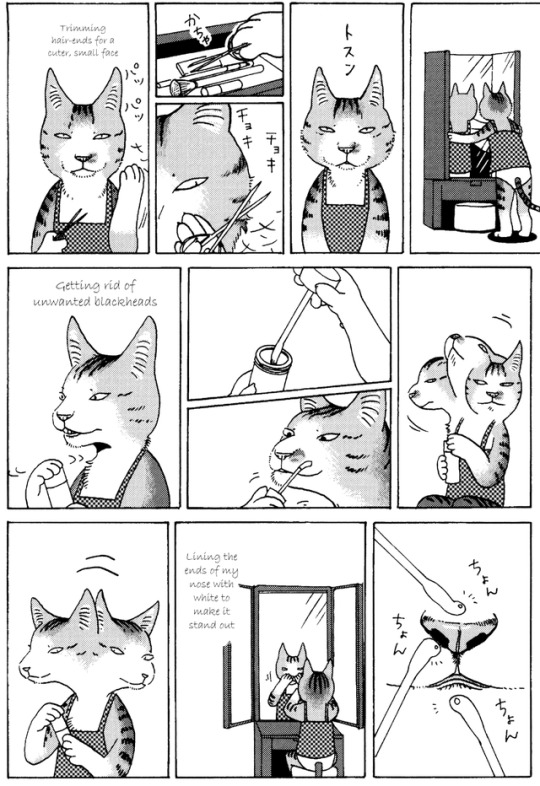
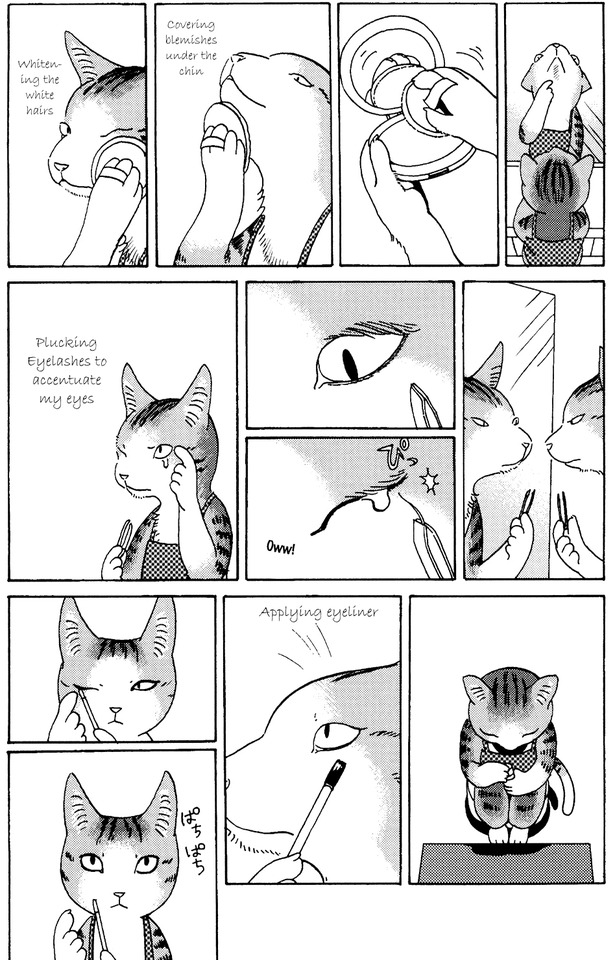

Terrarium in Drawer (Ryoko Kui)
4K notes
·
View notes
Photo

248 notes
·
View notes
Photo

Today’s Manga Screen of the day is brought to you by;
You don’t even know....
0 notes
Text
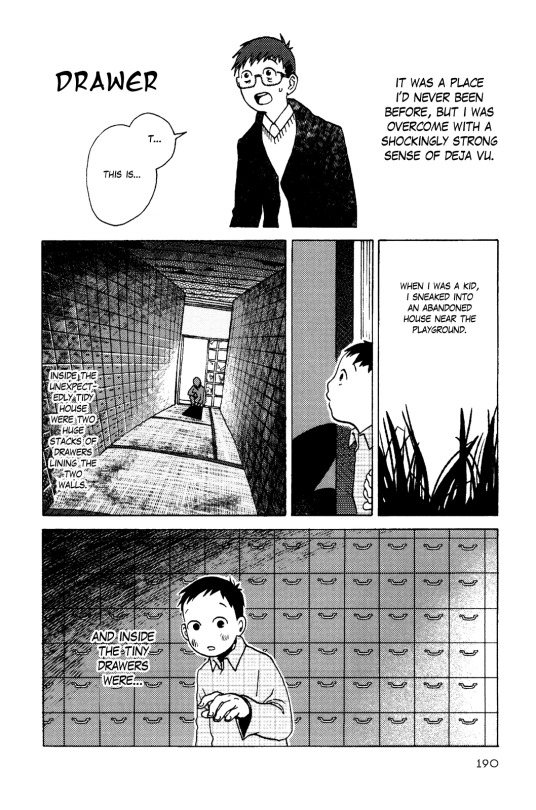
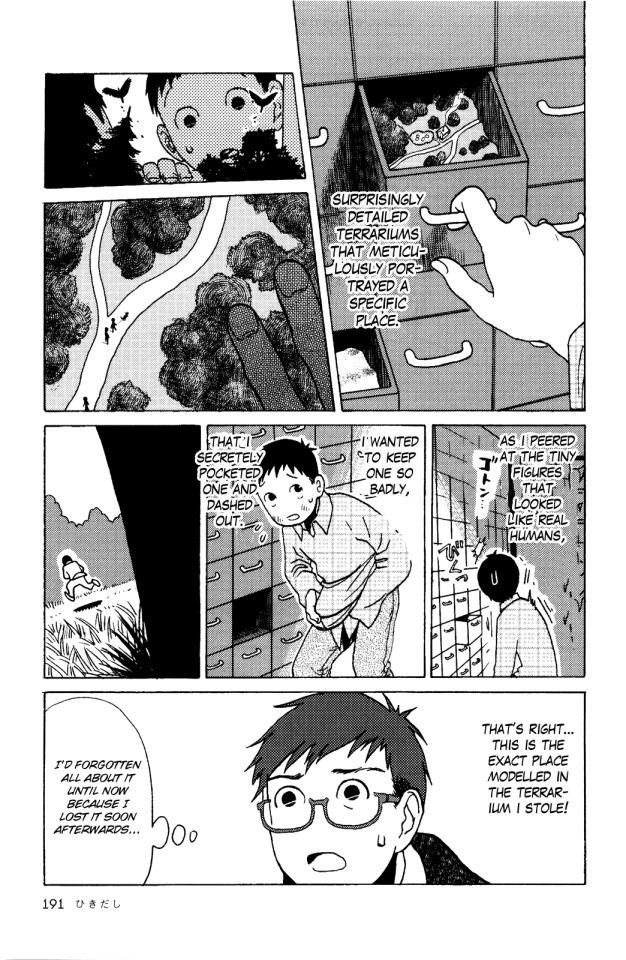
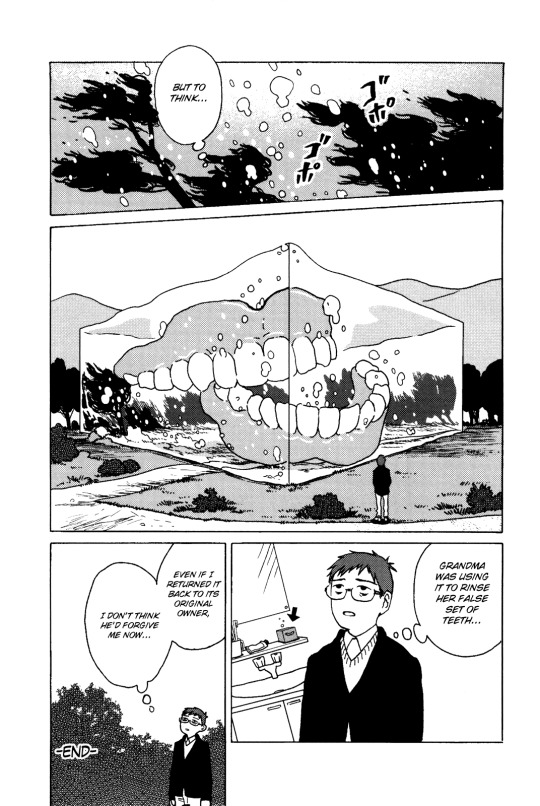
Terrarium in Drawer Ch. 30 - Drawer
10 notes
·
View notes
Text
went manga oneshot divng again
you can really see that kui sensei (dungeon meshi) is an ideas person in her anthology Hikidashi ni Terrarium. i didnt finish it so i'll get back to this. you never know what to expect next only that it will be conceptually interesting! i really want to play a ttrpg with her now.... i am unworthy...
im on ichikawa withdrawl with the hnk hiatus so i read her work ouji no himitsu. gotta love that ichikawa absurdism. actually her and kuu are both pretty absurdist
echoes by ayumi aparently got a reboot that is still ongoing as break the border i hope an english translation comes out eventually.
i tag scrolled on baka's (good ol trusty bakamangaupdates) trans tags and came across one i had seen some years ago and ah yes i remember why i stopped reading that one, theres nothing necessarily bad with hentai authors but...... it is a sign to keep expections low sakura-chan to amane-kun is kinda weird about its genderqueer characters. its not bad.... its just not good. also clearly written by a cis person.
niku wo hagu: at first i was worried the author was going to fetishize the transmale protagonist like a certain other series i wont mention (partly because i dont remember the title. clockwork...?) but i was pleasantly suprised with this one. its a good one. yikes chiaki you need mods to filter those comments, please take care of your mental health and dont have disturbing comments read out loud. on one hand streaming to his old account and pointing a gun at the camera has such bde. i was half expecting chiaki to shoot the camera and end his channel that way. if the audience for the old account was filled with trash, chiaki may have been better off starting a new account. but theres also something there of forcing his audience to confront that he's a man. at the center of this work is the relationship chiaki has with his father. with his father's caner diagnosis and refusal of treatment, chiaki must grapple with his father's impending death, a father who has never accepted chiaki as male. they love each other but each has skewed expectations on what would make the other happy. deeply affected by the death of his wife, the dad has clung to the traditional (and misogynistic) belief that a women finds happiness is marriage (to a man), chiaki meanwhile in the short time he has left with his dad only wants to his dad happy along those same lines even being willing to stage a fake marriage. is only when chiaki takes intiative for his happiness and clearly communicates that he's trans that things fall into place since what his dad actually wanted was for chaki to be happy. shoutout to chiaki's doctor too. oh yeah warning for depictions of butchery like cutting up the body of an aminal for meat. highly recommend this work.
next i checked back in with boys run the riot. i remember the series made it on my radar when the first chapter came out and i had a lukewarm response. reading more its a pretty good series tho not sure its my thing. "quit school jk not really and join my fashion brand". one thing i found a bit odd were how ryo's eyelashes are highlighted in the artstyle when the only other characters to have prominant lashes were female or wearing makeup. im not sure what to make of this artstyle/character design choice.
lastly i checked in on hideyoshico who has penned several works that I've enjoyed and glad to see them active again. they dropped off the radar back in like 2013 but it seems none of their recent stuff is translated i hope someone picks them up eventually.
well actually let me talk about a couple of mature content works. viewer discretion is advised. est em is fairly well known, her works have a very distinct atmosphere that is instantly recognizable. if you go searching for est ems's works just be wary of the content... like just all of the content warnings. all of them. like others including several webcomic artists equus left a lasting impression on me although hatarake kentarous is my favorite (you know, the only one that doesnt need content warnings). and she hasnt released anything in years, i wonder whats she's doing these days, get a different job... hmm. i came across blood sugar sex and magic by accident but the author writes such a compelling character dynamic between the main duo which culminates in a scene of genuine connection. but hooboy does this one have all the mature content in it from explicit sexual content, to illegal street drug usage, to organized crime, and all with minors. yikes. this author has also stopped drawing manga.
1 note
·
View note
Photo

Hikidashi ni Terrarium, Ryoko Kui (Mar 2013)
4 notes
·
View notes
Photo

⌈Hikidashi ni Terrarium⌋ by Kui Ryoko
25 notes
·
View notes
Text
Hikidashi ni Terrarium - Kui Ryoko

Fantasy volume, nominated for the 7th annual Manga Taishou Award. Full version of the cover (stitch) here.
ひきだしにテラリウム / 九井諒子
Mangaupdates
Download



?
4 notes
·
View notes
Photo

a splash page from hikidashi ni terrarium by kui ryouko
298 notes
·
View notes
Photo

103 notes
·
View notes
